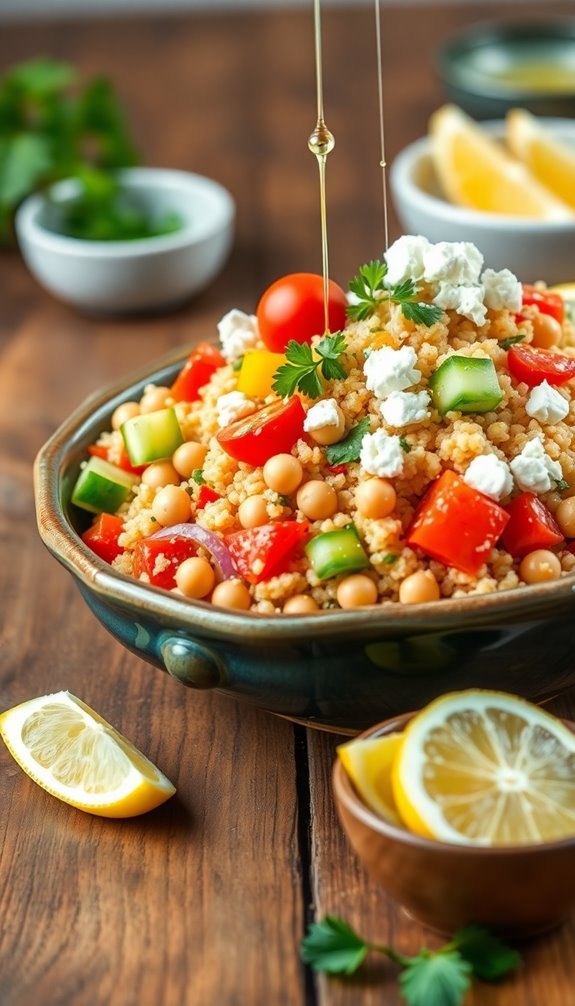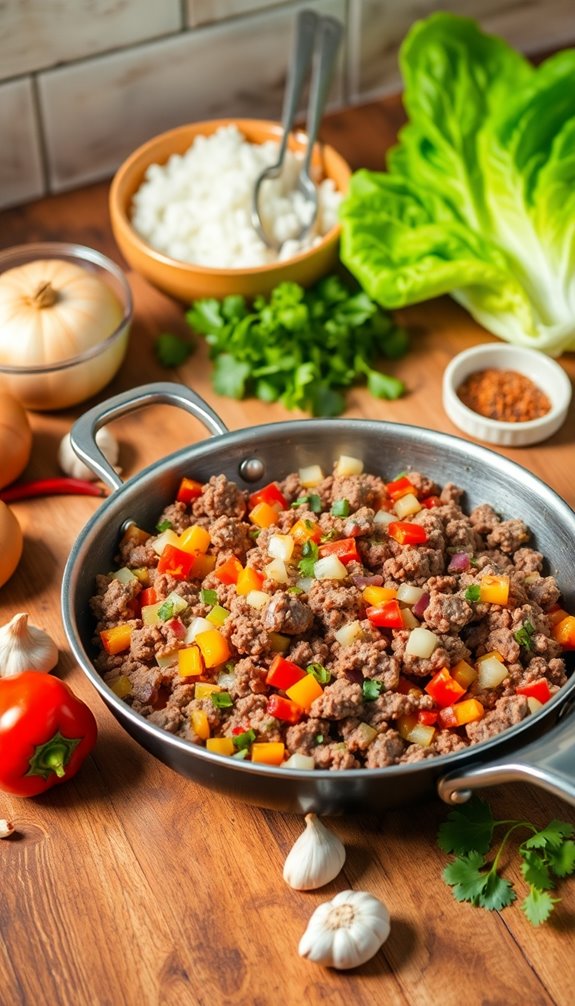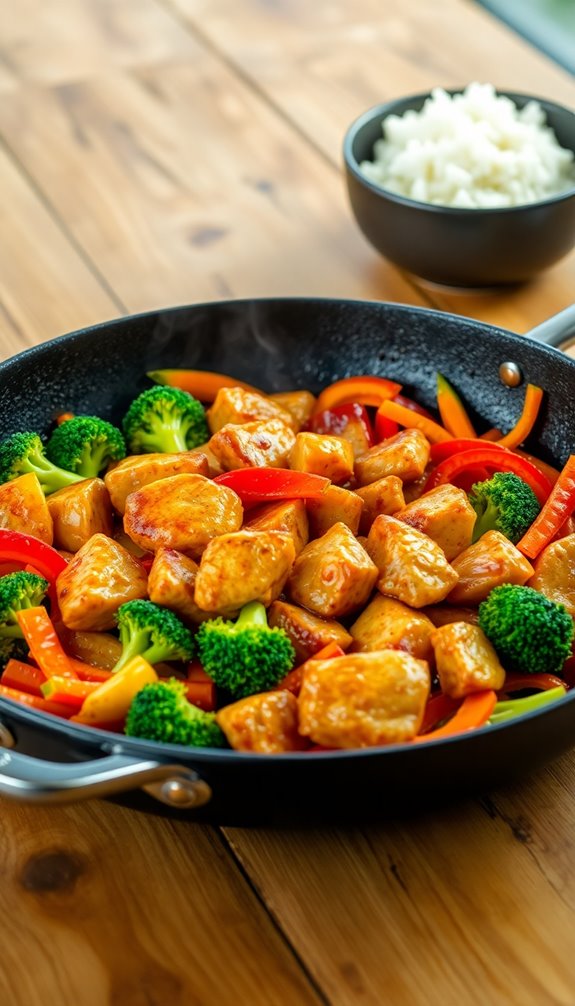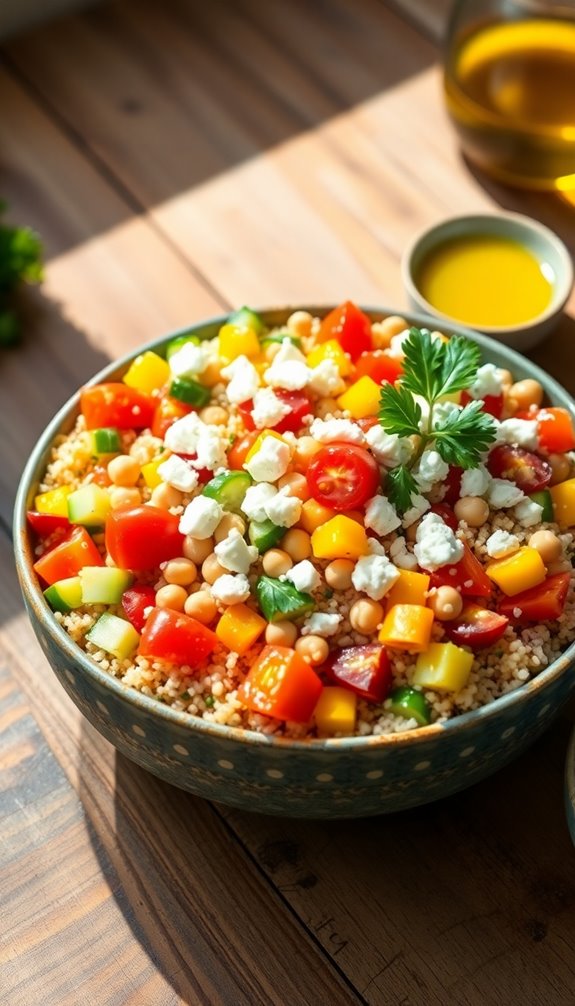The Mediterranean diet, often hailed as a blueprint for healthy eating, offers a variety of delicious lunch options. One standout choice is the Chickpea Salad with Quinoa, a dish that's both nutritious and satisfying. It's packed with protein and vibrant vegetables, making it ideal for anyone looking to boost their health. Curious about how to prepare this easy yet flavorful meal? Let's explore the steps involved in crafting this wholesome salad.
Recipe Tips and Tricks
- The Mediterranean diet emphasizes whole foods, healthy fats, lean proteins, and whole grains, promoting overall well-being and reducing chronic disease risk.
- A nutritious Mediterranean lunch option is Chickpea Salad with Quinoa, packed with protein, fiber, and colorful vegetables.
- This salad is simple to prepare, combining cooked quinoa, chickpeas, fresh vegetables, and a flavorful dressing of olive oil and lemon juice.
- Customize the salad by adding different legumes, fresh herbs, or additional vegetables like spinach and avocado for enhanced taste and nutrition.
- Meal prep by chopping veggies and cooking grains in advance, storing in airtight containers for fresh, healthy lunches throughout the week.
How To Make It – Recipe
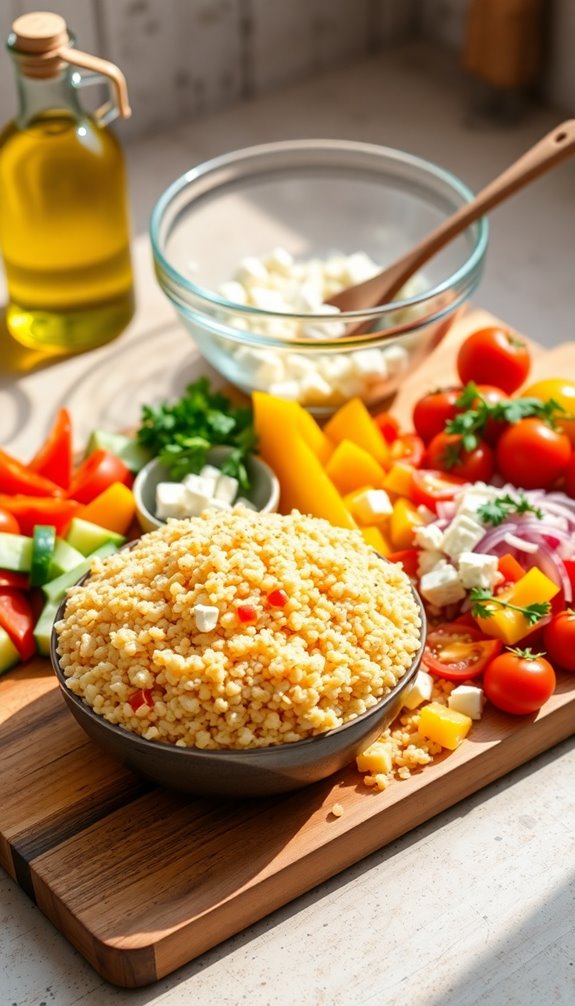
The Mediterranean diet is celebrated for its health benefits and delicious flavors, making it a perfect choice for a nutritious lunch. One of the standout dishes that embodies this cuisine is a hearty Chickpea Salad with Quinoa. This vibrant salad is packed with protein, fiber, and an array of colorful vegetables, making it a filling and satisfying meal.
Plus, it's easy to prepare and can be made in advance for meal prep or enjoyed fresh for a quick lunch. This recipe isn't only wholesome but also incredibly versatile. You can customize it according to your taste preferences or what you have on hand. The combination of chickpeas and quinoa provides a complete protein, while the fresh vegetables add crunch and a burst of flavor. Toss in some feta cheese for a salty touch, and you have a Mediterranean feast ready to enjoy!
Ingredients:
- 1 cup cooked quinoa
- 1 can (15 oz) chickpeas, drained and rinsed
- 1 cucumber, diced
- 1 bell pepper, diced
- 1 cup cherry tomatoes, halved
- ¼ red onion, finely chopped
- ¼ cup feta cheese, crumbled (optional)
- ¼ cup fresh parsley, chopped
- 3 tablespoons olive oil
- 2 tablespoons lemon juice
- Salt and pepper to taste
To prepare the Chickpea Salad with Quinoa, start by cooking the quinoa according to package instructions and let it cool. In a large mixing bowl, combine the cooked quinoa, chickpeas, cucumber, bell pepper, cherry tomatoes, red onion, feta cheese, and parsley.
In a separate small bowl, whisk together the olive oil, lemon juice, salt, and pepper to create a dressing. Pour the dressing over the salad mixture and toss everything gently until well combined. Adjust seasoning if needed, and serve immediately or refrigerate for later.
Extra Tips: When preparing this salad, feel free to add or substitute any vegetables you prefer, such as spinach, avocado, or olives for extra flavor. If you're meal prepping, store the salad without the dressing to keep the ingredients fresh. This salad can last up to 3-4 days in the refrigerator, making it an excellent option for busy weeks. Enjoy your Mediterranean lunch!
Additionally, incorporating healthy fats like olive oil in your diet can boost heart health and promote overall well-being.
Cooking Steps
To create a delicious Mediterranean lunch, start by chopping fresh vegetables finely to enhance their flavors. Next, drizzle in some olive oil and mix in crumbled feta cheese for a creamy texture. Finally, add generous amounts of fresh herbs and incorporate grilled chicken strips to complete your meal. Additionally, incorporating Mediterranean ingredients can elevate the taste profile of your dish.
Step 1. Chop Fresh Vegetables Finely
As you prepare your Mediterranean lunch, finely chopping fresh vegetables not only enhances their flavor but also improves their texture and presentation.
Use various chop techniques, like the dice or julienne method, to create uniform pieces from vegetable varieties such as bell peppers, cucumbers, and tomatoes.
This careful preparation guarantees each bite is delicious and visually appealing, making your meal even more enjoyable.
Step 2. Add Olive Oil Drizzle
Finely chopped vegetables are ready for the next step: adding a drizzle of high-quality olive oil.
This healthy fat not only enhances flavor but also offers numerous olive oil benefits, including heart health and anti-inflammatory properties.
Aim for about one to two tablespoons, ensuring even coverage. Mixing it in elevates your dish while promoting nutritious eating habits essential for the Mediterranean diet.
Step 3. Mix in Feta Cheese
Once you've drizzled the olive oil, it's time to incorporate feta cheese into your mix.
Crumble about half a cup of feta, as it adds a tangy flavor and beneficial nutrients like calcium and protein.
Compared to other cheese varieties, feta has lower calories and fat, making it a healthier choice.
Stir it in to enhance your Mediterranean lunch delightfully!
Step 4. Add Fresh Herbs Generously
Fresh herbs are an essential component of any Mediterranean dish, and adding them generously elevates the flavors of your lunch.
Use herbs like basil, parsley, or oregano for their numerous herb benefits, including antioxidants and anti-inflammatory properties.
Their vibrant taste not only enhances flavor but also supports your health, making your meal delicious and nutritious.
Don't hold back—add them liberally!
Step 5. Incorporate Grilled Chicken Strips
To create perfectly grilled chicken strips for your Mediterranean lunch, start by marinating the chicken in a mixture of olive oil, lemon juice, garlic, and your choice of herbs for at least 30 minutes.
Then, preheat your grill to medium-high heat.
Grill the chicken strips for about 6-8 minutes, ensuring they're cooked through.
This grilled chicken is a delicious, healthy protein addition to your meal.
Substitution Suggestions
While you may have a favorite Mediterranean dish, it's important to remember that you can easily customize it to suit your dietary needs or preferences.
Consider ingredient alternatives like quinoa instead of rice or chickpeas for added protein.
For flavor variations, try fresh herbs like dill or mint to enhance your meal.
These simple swaps can keep your lunches exciting and nutritious! Additionally, incorporating sweet potato recipes can provide a delicious twist to your Mediterranean-inspired dishes.
Serving Suggestions
Customizing your Mediterranean lunch isn't just about ingredient swaps; how you serve it can elevate the dining experience.
Consider using colorful plates and bowls to enhance visual appeal. Pay attention to serving sizes to promote portion control; this helps you enjoy a variety of foods without overeating.
Pair your meal with fresh herbs or a light drizzle of olive oil for an extra touch. Additionally, incorporating quick and delicious healthy lunch ideas can inspire creativity in your meal preparation.
Make-Ahead and Storage
When you plan ahead, preparing a Mediterranean lunch can be a breeze. Focus on meal prep by chopping veggies and cooking grains in advance. Store your meals in airtight containers to maintain freshness and flavor. Refrigerate for up to four days or freeze for longer storage. This way, you'll always have a nutritious option ready to go, making healthy eating effortless. Additionally, using a Crock Pot can simplify the cooking process and allow for effortless meal preparation.
Nutrition Facts(per serving)
Storing your Mediterranean meals properly not only keeps them fresh but also guarantees you maximize their nutritional benefits. Each serving typically boasts a caloric content of around 400-500 calories, making it a satisfying option. Rich in fruits, vegetables, and healthy fats, this diet offers impressive nutrient density, providing essential vitamins and minerals to support your overall health and well-being. Additionally, incorporating healthy lunch recipes into your routine can enhance your dietary variety and promote better eating habits.
Final Thoughts
As you embrace the Mediterranean diet, it's important to remember that its benefits extend beyond just delicious meals; they also foster a sustainable, healthy lifestyle. By incorporating healthy habits and effective meal planning, you can easily enjoy flavorful dishes while boosting your well-being. Research shows that the Mediterranean diet is linked to numerous health benefits, including reduced risk of chronic diseases. Stay consistent, experiment with recipes, and watch how these choices transform your health for the better.
Recipe FAQs
What Are the Benefits of the Mediterranean Diet?
Imagine savoring vibrant vegetables and healthy fats; you're enjoying a diet rich in nutrient diversity. It promotes weight management, boosts heart health, and enhances mental well-being, making it a delicious choice for a healthier lifestyle.
Can I Follow This Diet if I'm Vegetarian?
Yes, you can absolutely follow this diet as a vegetarian. There are plenty of vegetarian options available, including delicious plant-based recipes that emphasize fruits, vegetables, whole grains, legumes, and healthy fats, ensuring balanced nutrition.
How Does This Diet Affect Heart Health?
Think of your heart as a well-tuned engine. Following this diet can lower cholesterol levels and reduce heart disease risks, helping your heart run smoothly and efficiently, promoting overall cardiovascular health and longevity.
Are There Any Potential Downsides to the Mediterranean Diet?
While the Mediterranean diet offers numerous benefits, you might face cost considerations for fresh ingredients and time-consuming meal preparation. These factors could make it challenging to maintain the diet consistently in your daily routine.
How Can I Stay Motivated to Maintain This Diet?
To stay motivated, focus on meal planning to simplify your choices. Consider finding accountability partners who share your goals; they'll encourage you and help track your progress, making it easier to stick to your dietary commitments.

